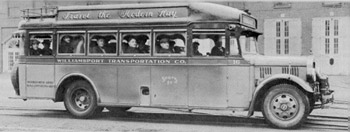Bush established headquarters for the Williamsport Transportation Company at the former Rothfuss garage on East Third and Penn Streets. This building housed the company’s management offices, a maintenance area, and the storage garage for the fleet. Service was started with 15 buses, and Bush basically kept the same routes, schedules, and hours of operation as the trolley system. The six routes were: Third Street, South Side, East End, West Fourth and Park Avenue, North Market and North Campbell, and Duboistown. Other than minor scheduling modifications to meet rush hour demand, there were few changes in this basic route system during Bush’s tenure.
As for employees for the new company, 35 former streetcar company employees qualified as bus drivers, and C. C. Fast, former manager of the Williamsport Railway Company and the Williamsport Transportation Company, served as the bus system’s first manager. Residents of the city were a bit amused by the different colors on the original buses and driver uniforms, but they already appreciated the faster and safer service that the buses provided.
Bush also immediately purchased several new buses from the Yellow Coach Company The first four, each seating 30 passengers, arrived on July 22, 1933 and were placed on the Fourth Street and Park Avenue line. All through the years that Bush controlled the company, new buses were always a high priority as he wanted to have the most modern fleet possible. By the Company’s second anniversary, it operated 24 buses and employed 57 people while carrying between 250,000 to 270,000 passengers each month and logging over one million vehicle-miles per year. In 1935 Bush expanded his control of transportation services by buying the Keystone Taxi Company from Raymond E. Bohartz. Under Bush’s ownership, a new fleet of taxicabs was placed in service with each vehicle equipped with a radio for quick dispatching. A new fare structure was also implemented. Now the charge was only 250 for the first 11/2 miles, and there was no charge for extra passengers.

In 1937 the Williamsport Transportation Company had to deal for the first time with an organized union of employees. In that year some of the bus operators formed a local union under a branch of the Electric Transportation and Motor Coach Employees of America, Division 1161, an affiliate of the American Federation of Labor. A grievance was immediately filed against the Company for the discharge of an operator involved in an accident. However, the situation was complicated when other employees voted to form a second union called the Busmen’s Independent Association. (There were charges that the owners played a role in the formation of this second union, but these were never substantiated.) Since the Pennsylvania Labor Relations Board would recognize only one bargaining unit, there had to be an election to determine which union would represent the employees. This was held on February 10, 1938, and in a very close vote the Amalgamated Association of Street Electric Railway and Motor Coach Employees of America was selected. The vote was 23 to 22. (In 1942 a new union was established which included all bus company employees, shop workers as well as drivers, and was called the Williamsport Transportation Company Employees’ Association. Still later, the employees again joined the Amalgamated Association of Street Electric Railway and Motor Coach Employees of America.) Normal operations of the bus system were significantly disrupted during World War II.
In an effort to conserve fuel, the War Board forced the Company to eliminate many of the usual bus stops. The Company also had to implement many route changes in order to serve workers going to and from defense plants. At the same time, normal ridership was growing by leaps and bounds because gasoline and tires were being rationed. This increase in use put a lot of pressure on the bus system which was having difficulty in obtaining new buses and parts. Although Bush was able to purchase two new buses in 1942, they had to be used to offset crowding problems rather than to replace worn-out existing buses. These war-time buses lacked many frills such as chromium trim and handrails, and were painted in only two colors.
As the end of the war approached, restrictions on gasoline and bus service were lifted, and the bus system resumed its pre-war schedule and routes. Ten new buses were purchased. These had a seating capacity of 38 and were manufactured by the American Car & Foundry Company of Philadelphia. The cost was $14,000 each.
In 1947, Raymond E. Bohartz, the former taxi owner, established a new bus system to provide service to Trout Run and the Garden View area. To prevent competition with the Williamsport Company, City Council only allowed Mr. Bohartz to pick up passengers traveling into and leaving the city.
Over the next few years, the bus system continued to grow and play a vital role in the development of the City and surrounding areas. The City’s planners considered it the life stream of the community and the only solution to the growing traffic problem. It was because of this problem that in March 1951 the City implemented a plan for one-way streets, forcing the bus system to relocate its downtown stops. The new stops were the south side of Third west of Court, the east side of Market south of Fourth, the north side of Fourth between Market and Court, and the west side of Market north of Fourth.


